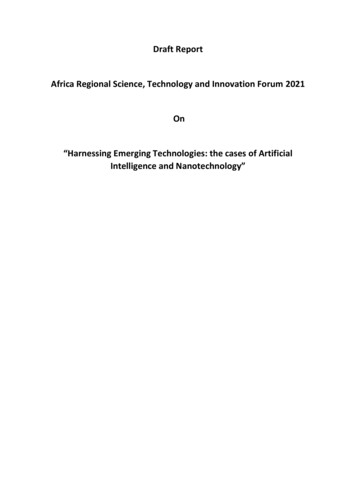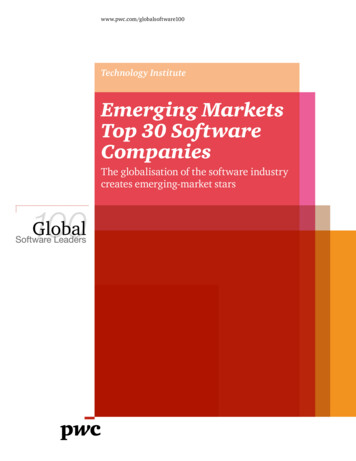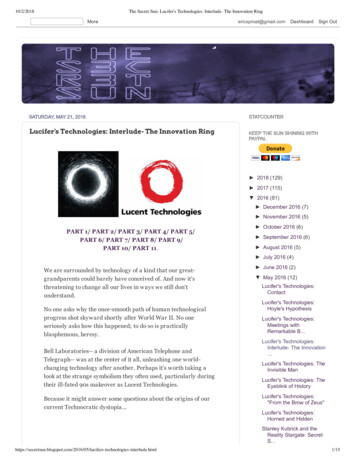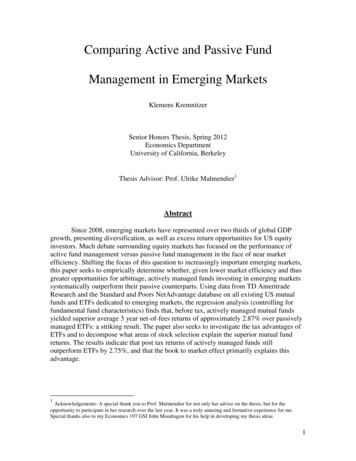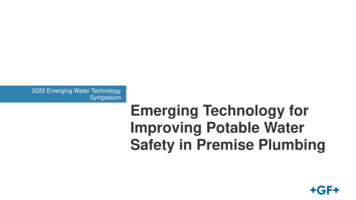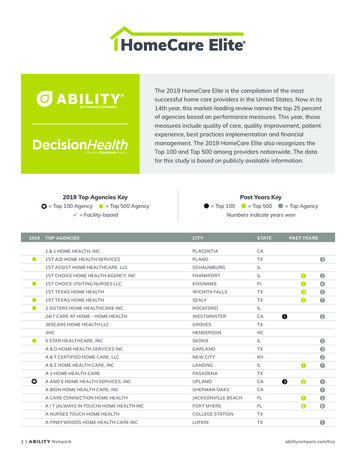
Transcription
Top 10 EmergingTechnologies of 2021INSIGHT REPORTNOVEMBER 2021
Illustrations by Vanessa BranchiContents3Introduction41Decarbonization rises62Crops that self-fertilise83Breath sensors diagnose diseases104On-demand drug manufacturing125Energy from wireless signals146Engineering better ageing167Green ammonia178Biomarker devices go wireless189Houses printed with local materials2010 Space connects the globe22ContributorsDisclaimerThis document is published by the WorldEconomic Forum as a contribution to aproject, insight area or interaction. Thefindings, interpretations and conclusionsexpressed herein are a result of acollaborative process facilitated andendorsed by the World Economic Forumbut whose results do not necessarilyrepresent the views of the World EconomicForum, nor the entirety of its Members,Partners or other stakeholders. 2021 World Economic Forum. All rightsreserved. No part of this publication maybe reproduced or transmitted in any formor by any means, including photocopyingand recording, or by any informationstorage and retrieval system.Top 10 Emerging Technologies of 20212
IntroductionInnovations to help tackle societal challenges –especially climate changeAuthorsMariette DiChristina and Bernard S. MeyersonThink of our planet’s grand challenges: managingclimate change; reducing energy use; sustainingfood production; improving global health. Many ofthese efforts involve overlapping problems – andthe potential for interlinked solutions. It’s no wonderthe United Nations names “Partnerships” as its 17thSustainable Development Goal.In this 10th edition of the Top 10 EmergingTechnologies, created by Scientific American andthe World Economic Forum, interlinking is frontand centre. With the acceleration of governmentand industry commitments for decarbonization,there will be an array of novel approaches inlow-emissions transportation, residential andcommercial infrastructure, and industrial processes.Two such technologies – the production of “green”ammonia and engineered crops that make their ownfertiliser – will improve agricultural sustainability. Inremote areas, 3-D printing with local soils will erectstronger houses with less energy.Because health is on everyone’s mind, this year’sTop 10 salutes the rise of breath sensors that candetect COVID-19 and other diseases, as well aswireless biomarker monitors that make it easierto diagnose and manage chronic illnesses. Newresults from the field of genomics could allow forthe engineering of longer “healthspans”, and ondemand drug manufacturing will result in tailoredmedicines while helping to solve today’s supplychallenges with large-scale production.To keep track of it all, the number of devices thatmake up the internet of things is rapidly growing.They will become more globally connected throughthe use of orbiting nanosatellites and be poweredby energy harvested from wireless signals. Thefuture has never looked so interconnected.Top 10 Emerging Technologies of 20213
C L I M AT E C H A N G E1Decarbonization risesSweeping commitments to address climatechange will birth new technologiesAuthorBernard S. MeyersonMore than a century after the first scientistargued that carbon dioxide could trap heat in theatmosphere and decades after “climate change”entered the vernacular, countries and industrieshave been making new commitments to cut theircarbon footprints. In 2021 the US, the secondlargest source of national carbon emissions,committed to halving its output relative to 2005levels by 2030. The United Kingdom announced itsown aggressive goal of a 68% reduction comparedto 1990 levels by that date. The European UnionParliament recently passed a law requiring carbonemissions reductions by at least 55% by 2030compared to 1990 levels. Although industriessuch as oil and aviation are more resistant tochange, the rate at which companies are joiningthe Science Based Targets initiative, which helpsthem reduce their emissions to stay in line withthe Paris Agreement, has doubled since 2015.General Motors, Volkswagen and other majorauto manufacturers have set ambitious targets fordecarbonization in the past year.This acceleration of commitments – along withthe associated challenges – is a clear indicatorof decarbonization’s emergence worldwide. Itwill force a diverse suite of technologies to“emerge” – that is, to demonstrate the ability tooperate at scale in the next three to five years.To make this a reality, solutions that have alreadybeen identified must mature and scale at greaterspeed. Existing technology gaps will requiresustained innovation. Several broad areas will seesignificant focus and growth.Top 10 Emerging Technologies of 20214
REUTERS/Toby MelvilleToday 2% or less of global private and commercialroadway transportation fleets produce zeroemissions, despite Tesla’s highly visible initialsuccess in driving consumer interest. Meanwhilebulk shipping, both rail and seaborne, has devisedlow-carbon solutions. Yet many of them, such asthe Coradia iLint, a passenger train powered byhydrogen fuel cells and manufactured by Alstom,have yet to be applied at scale. The barriers are notjust technological but also political, given that suchtransformational programmes require significantcapital investment.Meeting the power generation goals set bynations and industries requires a radicalexpansion of photovoltaic, wind, hydroelectric,tidal, nuclear and other zero-emissionstechnologies. Some critical hurdles remain.Reliable, efficient and affordable energy storageat the industrial scale is nascent. Carbon-free,fission-based nuclear energy (including disposalof its waste products) that is both safe andaffordable is also still aspirational. To lessen thepollution from existing fossil-fuel power generationwill require bringing on far more technologies thatcapture, reuse and sequester carbon.In the US, an estimated 13% of total carbonemissions come from fuel used for heating andcooking in residential and commercial buildings.Reducing that number there and elsewherewill require net-zero emissions HVAC (heating,ventilation and air-conditioning) and passive solarenvironmental systems to become commonplace. Itwill also be important to switch to natural and novelbuilding materials such as renewable timbers andlow-carbon cement.In the agriculture sector, protein substitutes such asthe Impossible Burger and Beyond Meat will needto take over a much greater share of the market tomitigate the massive levels of carbon and methaneproduced in raising livestock. Data from sensorsconnected via the internet of things will increasinglyenable intelligent land and crop management ,aswell as fertiliser and water use, aiding in furthercarbon reductions.As renewable energy sources become abundant,it will be necessary to employ them to decarbonizepervasive sources of greenhouse gases. Oneexample is “green” hydrogen. When producedwithout using carbon-based fuels, hydrogen canbecome a non-polluting fuel while also serving thechemical industry as a basic ingredient with nocarbon footprint. Similarly, if data centres, whichoften require megawatts of electricity, are colocated with the same renewable energy sources,their carbon footprint is dramatically reduced.In addition to the myriad technological challenges torapid decarbonization, nations must develop globalgovernance methods to ensure energy equality.Emerging economies cannot face identical carbonreduction targets that would stifle development.Nations will also need to thoughtfully allocateland to expand infrastructure for renewables.And to ensure compliance with global accords,governments will need global environmentalmonitoring infrastructure, similar to the protocols ofthe International Atomic Energy Agency.Top 10 Emerging Technologies of 20215
A G R I C U LT U R E2Crops that self-fertiliseRoot-grown instead of sownAuthorsWilfried Weber and Carlo RattiProviding food for the world’s growingpopulation relies heavily on the use ofnitrogen-containing industrial fertilisers. Some110 million tonnes of nitrogen are requiredto sustain global crop production annually,according to the Food and AgricultureOrganization of the United Nations. Nitrogenfertiliser is typically produced by convertingnitrogen from the air into ammonia, a form ofnitrogen that plants can use. This conversionsustains approximately 50% of global foodproduction and accounts for an estimated 1%of the world’s primary energy needs. But it isalso an energy-intensive process: it accountsfor 1% to 2% of global carbon dioxideemissions. Furthermore, industrial fertilisers aretoo expensive for smallholder farmers in manycountries, leading to strongly decreased yieldsand increased pressure on natural lands.To develop a solution, researchers are takingcues from nature’s own approach to makingnitrogen fertiliser. Whereas staple food cropssuch as corn and other cereals rely oninorganic nitrogen from the soil, legumeplants such as soy and beans havemaintained a clever way to produce theirown. The roots of legumes interact withsoil bacteria, leading to bacterial colonizationof the root and the formation of symbioticorgans called nodules. Within thesestructures, the plant provides sugars tosustain the bacteria and profits from thebacteria’s ability to fix nitrogen – that is,to convert atmospheric nitrogen intoammonia. Thus, through an evolutionarilyancient symbiosis with soil bacteria,legumes are independent of modernnitrogen fertilisers.Top 10 Emerging Technologies of 20216
GETTY/FotokosticResearchers have shown that the formation of thenodules – the natural fertiliser factories – involvesintimate molecular communication between soilbacteria and legume roots. This knowledge hasinspired exciting new approaches to engineeringnitrogen fixation into non-legume plants. Forexample, scientists are coaxing the roots ofcereals to engage in symbiotic interaction withnitrogen-fixing bacteria. The researchers emulatethe molecular communication between legumesand bacteria and steer the process by which thebacteria can colonize plant roots. In an alternativeapproach, soil bacteria that naturally colonizethe roots of cereals but cannot fix nitrogen aretaught to produce nitrogenase, the key enzymethat converts nitrogen from the air into plantcompatible ammonia.With governments and private foundationsrecently providing strong support for research anddevelopment in the area of engineering nitrogenfixation, crops that harness the power of naturalsymbiosis might soon become a key element of amore sustainable food production.Top 10 Emerging Technologies of 20217
BIOCHEMISTRY3Breath sensorsdiagnose diseasesPuffing is far faster than drawing bloodAuthorsRona Chandrawati and Daniel E. HurtadoWhen police officers suspect a motorist isintoxicated, they can use a Breathalyzer: ahandheld device that measures the level ofalcohol in the blood. Can the same be donefor disease diagnosis?The short answer is yes. Human breath containsmore than 800 compounds. Recent discoverieshave shown a strong correlation between certainconcentrations of compounds and differentdisease states. For example, breath with asignificantly elevated acetone concentration isa strong indication of diabetes mellitus; a higherconcentration of exhaled nitric oxide is correlatedwith inflamed cells and therefore can be used as abiomarker for respiratory diseases; greater amountsof aldehydes are closely related to lung cancer.When a person puffs into a sampler, that breath isfed into a sensor that generally makes detectionsbased on changes in the electrical resistance ofmetal oxide semiconductors. Within minutes,an external computer uses software analysis togenerate a profile of the compounds present.Beyond delivering results far faster than a blooddraw, breath sensors could streamline medicaldiagnostics by providing a non-invasive way toTop 10 Emerging Technologies of 20218
collect critical health data. In low-income countrieswith limited medical resources, their ease of use,portability and cost-effectiveness provide newopportunities for healthcare. These devices couldalso help mitigate community spread of a virus in amanner similar to how temperature checks screenindividuals before they enter shared indoor spacessuch as supermarkets or restaurants.In March 2020 Hossam Haick and colleagues atTechnion-Israel Institute of Technology concludedan exploratory clinical study in Wuhan, China,for COVID-19 detection in exhaled breath. Thesensors achieved a remarkable 95% accuracyand 100% sensitivity in differentiating people whowere positive or negative for the disease. In 2021the US Department of Health and Human Servicesprovided 3.8 million to repurpose NASA’s E-Nose –a monitor that uses nanosensor array technologiesto autonomously scan the air on the InternationalSpace Station for potentially dangerous chemicals –to detect COVID-19.Critical challenges need to be met beforebreath-sensor technology becomes widespread.First, detection accuracy must be improved forsome diseases, particularly for tuberculosis andcancer. Second, various compounds in a breathsample can confound test results, creating falsepositives. The algorithms that analyse sensor datawill also need to be improved to reach greateraccuracy. Finally, bigger investments in clinicaltrials are needed to help validate this technologyin large populations.REUTERS/Chen LinTop 10 Emerging Technologies of 20219
ENGINEERING4On-demand drugmanufacturingMaking pharmaceuticals where and when theyare neededAuthorsElizabeth O’Day and Mine OrluWhat if the next time you went to your localpharmacy, rather than the pharmacist lookingthrough aisles of premade drugs to fill yourprescription, they made it to the exact dose andformulation tailored for you? Recent advances inmicrofluidics and on-demand drug manufacturingare poised to make this idea a reality.Traditionally drug products are made in largebatches through a multistep process with differentparts dispersed among many locations worldwide.Hundreds of tonnes of material support such massproduction, creating challenges in ensuring theconsistency required for both quality and reliablesupply. It can take several months to completedrugs and deliver them to stores.In contrast, on-demand drug manufacturing,also known as continuous-flow pharmaceuticalmanufacturing, makes drugs all in one go. It worksby flowing ingredients via tubes into a series ofsmall reaction chambers. Producing drugs asneeded at a single site means that drugs can bemade in remote locations or in field hospitals.Top 10 Emerging Technologies of 202110
GETTY/FahroniIt also means fewer resources are needed to storeand transport drugs and that doses can be tailoredto individual patients.In 2016 researchers at the MassachusettsInstitute of Technology (MIT) working with DARPA(the US Defense Advanced Research ProjectsAgency) first demonstrated it was possible to makeon-demand drugs. They created a refrigerator-sizemachine that uses continuous flow to make fourcommon drugs: diphenhydramine hydrochloride,which is used to relieve symptoms of allergy;diazepam, which is used to treat anxiety andmuscle spasms; the antidepressant fluoxetinehydrochloride; and the local anaesthetic lidocainehydrochloride. They made 1,000 doses of eachdrug within 24 hours.On Demand Pharmaceuticals is nowcommercializing the original MIT work, withseveral platforms available or in development,including American Made Precursors on Demand(AMPoD), which enables full drug-productmanufacturing – from precursor to final formulation;Bio-Mod, which enables the manufacture ofbiologics; and IV Medicines on Demand, whichproduces sterile injectables. A number ofpharmaceutical manufacturers, among them EliLilly, Johnson & Johnson, Novartis, Pfizer andVertex Pharmaceuticals, are also making use ofcontinuous-manufacturing technology at least forparts of their manufacturing processes.Portable machines for on-demand drugmanufacturing currently cost millions of dollars,preventing widespread rollout. New qualityassurance and quality control methods will alsobe needed to regulate both the personalization offormulas and single-person drug batches. As costgoes down and regulatory frameworks evolve, ondemand manufacturing may revolutionize where,when and how drugs are made.Top 10 Emerging Technologies of 202111
COMPUTING5Energy fromwireless signals5G will help power the internet of thingsAuthorJoseph CostantineThe wireless devices that make up the internetof things (IoT) constitute the backbone of anever-more networked world. They are deployedas gadgets in homes, as wearable devices forbiomedical uses, and as sensors in hazardousand hard-to-reach areas. As the IoT grows, it isenabling agricultural practices that use less waterand pesticide; more energy-efficient smart grids;sensors that monitor flaws that can weakenbridges or concrete infrastructure; and earlywarning sensors for disasters such as mudslidesand earthquakes.With an estimated 40 billion IoT devices comingonline by 2025, providing convenient, on-demandpower to those devices is a fast-growing challenge.One solution that is already in the works leveragesthe wireless signals emanating from Wi-Fi routersand access points. The emerging fifth generationof cellular technology, or 5G, will elevate wirelessenergy harvesting to a new level.With 5G, the US Federal CommunicationsCommission is allowing cell signals to move into thehigher (but still safe for humans) millimetre rangeTop 10 Emerging Technologies of 202112
REUTERS/George Freyof the electromagnetic spectrum for the first time.Along with higher information rates, 5G wirelesssignals transmit a greater amount of radiatedenergy than 4G. This capability points to a futurewhere many low-power wireless devices never needto plug in to charge.in turn uses semiconductors to convert it into adirect-current (DC) voltage that can charge orpower a device. This combination of antenna andrectifier (or converter) is called a rectenna. A powermanagement circuit follows the rectenna, amplifyingthe voltage while consuming negligible power itself.How can devices grab power from wireless signals?Wi-Fi and 5G are electromagnetic waves thatpropagate at frequencies within the broad spectrumbetween FM radio, microwaves and millimetrewaves. The first step of the process involves areceiving antenna that captures energy carriedwith the wireless signal. The antenna routes thatenergy into an electronic rectifier circuit, whichMany start-up companies are now offering wirelesscharging products that rely on dedicated wirelesstransmitters; research suggests it is likely, however,that such devices will be able to harvest Wi-Fi and5G signals in the near future. Just as cell phoneshave freed populations from landlines and havetransformed communication abilities, this emergingtechnology will provide further freedom.Top 10 Emerging Technologies of 202113
GENOMICS6Engineering betterageingA focus on increasing “healthspan”,not just lifespanAuthorsWilfried Weber and P. Murali DoraiswamyAccording to the World Health Organization, between2015 and 2050 the proportion of the global populationolder than 60 will nearly double from 12% to 22%,posing enormous challenges to health and socialsystems. Ageing is related to chronic diseases such asdementia, cancer, type 2 diabetes and atherosclerosis.The desire to reverse ageing or to find a “fountain ofyouth” is likely as old as humankind. Understandingthe molecular mechanisms of ageing that could helphumans lead lives that are not just longer but healthieris just beginning.Through the advent and refinement of so-calledomics technologies (which simultaneouslyquantify, for example, the activity of all genes orthe concentration of all proteins and metabolitesin a cell), combined with insights from epigenetics,those key mechanisms are becoming clearer. Oneexciting example involves combinations of specificepigenetic marks (modifications that change geneactivity because of behaviour and environment) ormetabolic compounds that can serve as identifiersof an organism’s biological age.Top 10 Emerging Technologies of 202114
GETTY/EplisterraSuch marks also are strong predictors of diseasesin the elderly and the accompanying risk of death.Advances in sequencing the genetic information ofsingle cells in an organism have demonstrated thatthe number of mutations increases during ageing;the body’s repair of such mutations may leaveageing-related traces on the DNA – another type ofmarker. DNA damage is also associated with drivingcells into senescence (meaning they can no longerreproduce) or exhausting the stem cells that are keyfor cell and tissue renewal.This recent and continuously growing understandingof ageing mechanisms is enabling the developmentof targeted therapies. For example, one recentinitial clinical study suggested that a one-yearlong administration of a pharmaceutical cocktailincluding human growth hormone could turn backthe “biological clock” 1.5 years. Similarly, researcherssuccessfully demonstrated in a rodent modelthat gene therapy targeting three longevity-linkedgenes could improve or reverse four common agerelated conditions. Scientists have also identifiedproteins in the blood of young humans that, wheninfused into older mice, improved markers ofage-related brain dysfunction. The result suggeststherapeutic potential to reverse human age-relatedcognitive decline.Inspired by new insights into the ageing processat the molecular level and encouraged by the firstpromising results from clinical trials, more than 100companies are actively developing pharmaceuticalor gene-engineering approaches to analyse andengineer the “healthspan” and lifespan. Most ofthese companies are at preclinical stages or earlyclinical trials. This R&D, backed by investors’ highexpectations, fuels hopes for healthier elderly years.Top 10 Emerging Technologies of 202115
CHEMISTRY7Green ammoniaReducing the CO2 footprint offertiliser productionAuthorsJavier García Martínez and Sarah E. FawcettThe Haber-Bosch process – arguably one ofthe most important inventions of the 20th centurythat many people have never heard of – enablesthe synthesis of ammonia on an industrial scale.This ammonia is used to produce the fertilisersthat fuel 50% of global food production, makingit a key to food security around the world.Ammonia synthesis, however, is an energy-intensivechemical process that requires a catalyst to fixnitrogen with hydrogen.Unlike nitrogen, which makes up most of theair, hydrogen must be synthetically producedand is currently generated using fossil fuels.Natural gas, coal or oil is exposed to steam athigh temperatures to generate hydrogen gas.Problematically, this process yields vast amounts ofcarbon dioxide, accounting for 1% to 2% oftotal global emissions.Green hydrogen, produced by splitting water usingrenewable energy, promises to change that. Inaddition to eliminating carbon emissions duringhydrogen production, the process has a significantlypurer end result. It is free of chemicals incorporatedin fossil fuels, such as compounds containingsulphur and arsenic that can “poison” the catalyst,thereby reducing reaction efficiency.Cleaner hydrogen also means that superiorcatalysts can be developed because they no longerneed to tolerate the poisonous chemicals from fossilfuels. In fact, companies such as Denmark’s HaldorTopsoe have already announced the developmentof novel catalysts from entirely renewable sourcesfor green ammonia production.Spanish fertiliser producer Fertiberia is partneringwith energy company Iberdrola to vastly expandgreen ammonia plans, from a 20-megawatt pilotplant that will be operational in 2021 to a full 800MW of solar-driven electrolytic hydrogen productionby 2027. The investment, estimated at 1.8 billion,is expected to generate 4,000 jobs and save400,000 tonnes of CO2 a year, equivalent to theemissions of about 60,000 cars.A major obstacle is the current high cost of greenhydrogen. To help solve that problem, 30 Europeanenergy players have launched HyDeal Ambition, aproject aiming to deliver green hydrogen at 1.5per kilogram before 2030 through innovations in theproduction, storage and transport of hydrogen. Ifsuccessful, the effort could unleash a whole rangeof new applications for green ammonia, includingits ability to be decomposed back into hydrogen –enabling a virtuous green hydrogen-ammonia circle.GETTY/Saoirse 2010Top 10 Emerging Technologies of 202116
B I O I N F O R M AT I C S8Biomarker devicesgo wirelessContinuous, non-invasive monitoringof chronic diseasesAuthorJoseph CostantineNobody likes needles. But monitoring chronicdiseases such as diabetes and cancer requiresfrequent blood work to identify and track certainbiological markers, or biomarkers. Now more than100 companies are developing wireless, portableand wearable sensors that will soon enablecontinuous monitoring of this vital information.with electromagnetic waves within the microwaverange. In a third effort, tattoo-based circuitryevaluates glucose in sweat by employing electrodesto produce tiny amounts drawn from the interstitialfluids that naturally leak out of capillaries. Similar toglucose detectors, tattoo-like circuits could samplesweat for changes in lactate, an application that isdrawing investment from the athletics industry.Monitors use a variety of approaches to detectbiomarkers in sweat, tears, urine or blood.Some use light or low-power electromagneticradiation (similar to cell phones or smart watches),combined with antennas and electronics, topeer into tissue. Others involve wearable, flexibleelectronic sensors atop skin. To detect a givenbiomarker, monitors seek a change in current,voltage or electrochemical concentration.The wireless transmission systems can be pairedwith various types of sensors, including those madewith densely aligned carbon nanotubes or ones thatdrive magnetic nanoparticles into tiny microfluidicchannels to detect biomarkers through a changein voltage or current. Such technologies openthe door for an “electronic tongue” that is able todistinguish various liquid samples.Diabetes is a top target for this technology, with 578million people globally expected to be diagnosedwith the disease by 2030. To meet the rising needto check glucose levels, one portable devicepromises non-invasive monitoring using wirelesselectromagnetic fields at millimetre waves and nearinfrared sensing. The voltage variation in a patient’sfinger can be correlated to the glucose level. Inanother approach, wearable electronics embeddedin clothing detect glucose levels in the bloodstreamTears can be surprisingly revealing as well.Electronic, transparent contact lenses can wirelesslypick up cancer biomarkers or glucose levels fordiabetes monitoring. Saliva biomarkers may indicatephysiological and psychological stress or diseasessuch as HIV, intestinal infections, cancer andCOVID-19. When integrated in a mouth guard thathas radio-frequency identification technology, salivasensors can also monitor oral health, detectingdecay or anomalies.GETTY/LPETTETTop 10 Emerging Technologies of 202117
M AT E R I A L S S C I E N C E9Houses printed withlocal materialsConcrete is swapped for soilAuthorsBernard S. Meyerson and Carlo RattiTechnologies such as childhood vaccines or LASIKeye surgery tend to dramatically improve qualityof life for many people in the industrial world. Buttheir influence in developing nations has often beenfar more limited or significantly delayed. Buildinghouses with 3-D printers, however, could helptackle the challenge of inadequate housing for1.6 billion people worldwide, according to UnitedNations estimates. The concept of 3-D printinghouses is not new. Several enterprises have printedhomes on Long Island in New York and in Austin,Texas, with promising results. Materials such asconcrete and various mixtures of sand, plasticsand binders are trucked to the building site andextruded through a massive 3-D printer. As arelatively simple and low-cost construction method,3-D printing houses seems well-suited to mitigatinghousing struggles in remote, impoverished regions.But the lack of infrastructure to transport materialshas precluded its use.Recently various firms have taken inspiration fromprojects intended for Mars, where local materialsare the only option available. In the small town ofMassa Lombarda, Italy, one prototype designedby Mario Cucinella Architects uses local clay soil toprint housing components, dramatically reducingconstruction complexity, cost and energy use. TheTop 10 Emerging Technologies of 202118
REUTERS/Andreas Gebertsoil is mixed with hemp and a liquidbinder, then extruded layer by layer by Italian3-D printing company WASP into the complexshapes and surfaces required of a dwelling.Using native materials eliminates about 95% ofthe mass that would typically need to betransported to a site.Another approach, demonstrated by WASP incollaboration with designer RiceHouse, is inspiredby centuries of experience in creating mud bricksin arid regions. The process involves blending thetraditional mixture of mud with a binding filament,which can be naturally occurring fibre. Instead ofhand pressing the base material into a mould, thematerial is pumped through a 3-D printer suppliedby WASP to create a house in far less time thanrequired with traditional methods – and with extrastrength granted by the rigid geometry of theprinted walls. Much of the base material is sourcedfrom the construction site itself.With the WASP approach, structures that havereached the end of their usable life can simply bebroken down to their base materials and thosematerials can be reused. This zero-waste, orcircular, model goes back thousands of years.Today homes constructed of residual materials from10 centuries of homes that came before them stillexist on Mount Erice in Sicily.Top 10 Emerging Technologies of 202119
ENGINEERING AND COMPUTING10Space connectsthe globeThe internet of things goes into orbitAuthorRajalakshmi
Emerging economies cannot face identical carbon reduction targets that would stifle development. Nations will also need to thoughtfully allocate land to expand infrastructure for renewables. And to ensure compliance with global accords, governments will need global environmental monitoring infrastructure, similar to the protocols of


